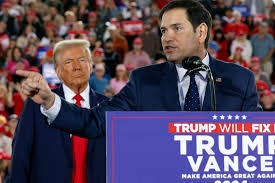
On April 22, 2025, U.S. Secretary of State Marco Rubio announced a comprehensive reorganization of the State Department to align with President Trump’s America First foreign policy. The plan aims to reduce bureaucracy, eliminate redundant offices, and consolidate region-specific functions to enhance efficiency.
Non-statutory programs misaligned with U.S. interests will be terminated, and USAID functions will be integrated into regional bureaus. The reorganization is a roadmap, not an immediate overhaul, with no immediate firings. The goal is to empower diplomats, streamline operations, and prioritize U.S. national interests in a new era of great power competition.
Bottomline:
Rubio’s reorganization plan is a bold attempt to modernize the State Department. It prioritizes efficiency, accountability, and U.S. interests. The plan’s success depends on its implementation over the coming months. Stakeholders, including diplomats and foreign partners, will closely watch how the department balances cost-cutting with its global responsibilities.
Resources for this report:
New State Department Substack
A New State Department to Meet the Challenges of a New Era
Department Press Briefing – April 22, 2025
Tammy Bruce, Department Spokesperson
Building an America First State Department
Marco Rubio, Secretary of State
Background and Context:
The State Department has faced criticism for its bloated structure and inefficiency. Over the past 15 years, its size and costs have grown significantly, yet diplomatic outcomes have not improved, according to a State Department statement. Rubio argues the department is “unable to perform its essential diplomatic mission” due to bureaucratic sprawl and ideological capture Rubio wrote. The reorganization plan, detailed in press briefings and statements, seeks to address these issues by restructuring bureaus, eliminating redundant offices, and refocusing on U.S. interests.
Key Points from Sources:
Rubio’s Written Statement (State.gov):
Rubio’s press statement outlines the reorganization’s objectives. “We are facing tremendous challenges across the globe,” Rubio states, emphasizing the need to “make the State Department Great Again” (Rubio, 2025a). The plan consolidates region-specific functions, removes redundant offices, and terminates programs misaligned with U.S. interests. Rubio highlights the department’s growth over 15 years, noting that taxpayers have seen “less effective and efficient diplomacy” despite increased costs Rubio wrote. The new organizational chart, available on State.gov, will be implemented over several months.
Read:
Rubio’s Substack Post:
Rubio’s Substack article provides deeper insight into the department’s issues. He describes a “bloated, bureaucratic swamp” where “bureaus and offices fight to be included on the approval chains for the most mundane of memos” Rubio said. He cites the Global Engagement Center (GEC), recently shuttered, as an example of bureaucratic overreach, accusing it of censoring speech, including that of the President (Rubio, 2025b). The reorganization will streamline functions, with regional bureaus handling region-specific tasks and economic policy consolidated under one undersecretary. The former Under Secretary for Civilian Security, Human Rights, and Democracy (“J Family”) is criticized for enabling ideological activism, such as funding NGOs that facilitate mass migration Rubio wrote in his substack. USAID functions will be integrated into regional bureaus to ensure aid aligns with U.S. goals.
Read:
Tammy Bruce’s Live Briefing:
During a live briefing, spokesperson Tammy Bruce elaborated on the reorganization. “We are reversing decades of bloat and bureaucracy,” she stated, emphasizing that the plan empowers diplomats to prioritize U.S. interests. Tammy Bruce told the media. Bruce clarified that this is a roadmap, not an immediate overhaul: “It is not something where people are being fired today,” Bruce said on Monday. She addressed USAID’s integration, noting that aid decisions will now involve embassies and regional bureaus to ensure relevance to recipient nations. Bruce also responded to concerns about eliminated offices, such as the Office of Global Criminal Justice, insisting that issues like war crimes remain priorities but will be handled differently within restructured bureaus.
Watch:
Analysis and Implications:
The reorganization reflects a shift toward efficiency and alignment with Trump’s America First agenda. By consolidating functions and eliminating offices like the GEC, the plan aims to reduce costs and ideological influence. However, the elimination of the “J Family” and offices like Global Criminal Justice raises questions about the department’s commitment to human rights and democracy promotion for Trump’s opposition. Bruce’s assurance that these issues will be integrated into other bureaus may not fully address concerns about diminished focus. The integration of USAID into regional bureaus could improve aid coordination, but risks disrupting existing programs if not managed carefully.
Conclusion:
Rubio’s reorganization plan is a bold attempt to modernize the State Department. It prioritizes efficiency, accountability, and U.S. interests. The plan’s success depends on its implementation over the coming months. Stakeholders, including diplomats and foreign partners, will closely watch how the department balances cost-cutting with its global responsibilities.
